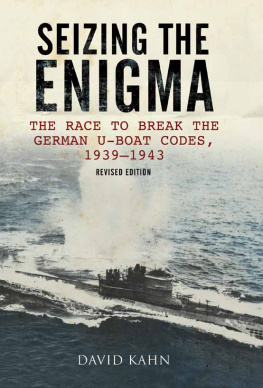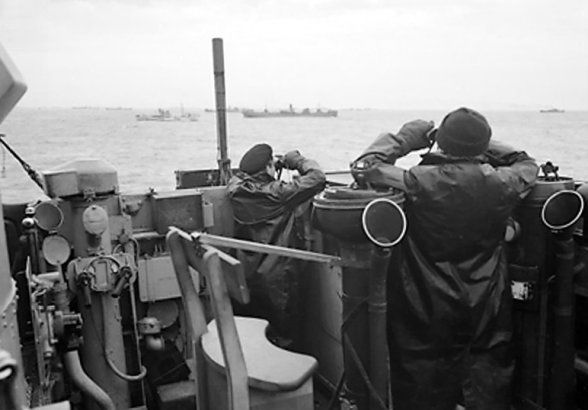Charles River Editors provides superior editing and original writing services across the digital publishing industry, with the expertise to create digital content for publishers across a vast range of subject matter. In addition to providing original digital content for third party publishers, we also republish civilizations greatest literary works, bringing them to new generations of readers via ebooks.
Sign up here to receive updates about free books as we publish them , and visit Our Kindle Author Page to browse todays free promotions and our most recently published Kindle titles.
Introduction

A picture of a German sub hitting a merchant ship with torpedoes
Submarine Warfare in the Atlantic
We in the tower were given a chance to view the holocaust. Three vessels lay heavily listing, shooting smoke and fire columns into the air. White lifeboats hung head-down in their davits. Two destroyers raced toward the dying ships. It was a painting of rare and vivid colors. U-boat commander Herbert A. Werner, describing a submarine attack in August 1941 (Werner, 2002, 53).
Danger prowled under both the cold gray waters of the North Sea and the shimmering blue waves of the tropical Atlantic during World War II as Adolf Hitler's Third Reich attempted to strangle Allied shipping lanes with U-boat attacks. German and British submarines combed the vast oceanic battlefield for prey, while scientists developed new technologies and countermeasures.
Submarine warfare began tentatively during the American Civil War (though the Netherlands and England made small prototypes centuries earlier, and the American sergeant Ezra Lee piloted the one-man Turtle vainly against HMS Eagle near New York in 1776). Britisher Robert Whitehead's invention of the torpedo introduced the weapon later used most frequently by submarines. Steady improvements to Whitehead's design led to the military torpedoes deployed against shipping during both World Wars.
World War I witnessed the First Battle of the Atlantic, when the Kaiserreich unleashed its U-boats against England. During the war's 52.5 months, the German submarines sent much of the British merchant marine to the bottom. Indeed, German reliance on U-boats in both World War I and World War II stemmed largely from their nation's geography. The Germans eventually recognized the primacy of the Royal Navy and its capacity to blockade Germany's short coastline in the event of war. While the British could easily interdict surface ships, submarines slipped from their Kiel or Hamburg anchorages unseen, able to prey upon England's merchant shipping.
During World War I, German U-boats operated solo except on one occasion. Initially, the British and nations supplying England with food and materiel scattered vessels singly across the ocean, making them vulnerable to the lone submarines. However, widespread late war re-adoption of the convoy system tipped the odds in the surface ships' favor, as one U-boat skipper described: The oceans at once became bare and empty; for long periods at a time the U-boats, operating individually, would see nothing at all; and then suddenly up would loom a huge concourse of ships, thirty or fifty or more of them, surrounded by a strong escort of warships of all types. (Blair, 1996, 55).
World War I proved the value of submarines, ensuring their widespread employment in the next conflict. Besides Germany and Britain, Japan and the United States also built extensive submarine fleets before and/or during the war. One critical innovation in World War II's Atlantic U-boat operations consisted of wolf-pack tactics, in which Admiral Karl Dnitz put great faith: The greater the number of U-boats that could be brought simultaneously into the attack, the more favourable would become the opportunities offered to each individual attacker. [] it was obvious that, on strategic and general tactical grounds, attacks on convoys must be carried out by a number of U-boats acting in unison. (Dnitz, 1990, 4).
However, even the wolf-pack proved insufficient to defeat the Atlantic convoys and stop Allied commerce the precise opposite of the Pacific theater, where America's excellent submarine forces annihilated much of Japan's merchant marine and inflicted severe damage on the Imperial Japanese Navy.
Submarine Warfare in the Atlantic: The History of the Fighting Under the Waves between the Allies and Nazi Germany during World War II analyzes the underwater fighting between the Allies and Germany across the Atlantic theater. Along with pictures of important people, places, and events, you will learn about submarine warfare like never before, in no time at all.
Chapter 1: The Importance of the Atlantic
The fighting for control of the Atlantic represented an arms race on multiple levels, including both offensive weapons systems and defensive countermeasures. While the Allies honed their convoy technology and improved its use, the Germans added new features to their U-boats, enabling them to move faster, hit harder, and attempt to escape after an attack in a more effective manner. The back-and-forth exchange witnessed the Germans discovering a fresh weakness, exploiting it, and then, after a brief period of notable success, losing ground to new countermeasures. In this race, the Allies eventually outpaced the Axis, leading to the effective defeat of the U-boats and their reduction to a mere annoyance later in the war.
The stakes of this naval struggle remained very high throughout the war. America's control of the sea lanes provided Britain with food and weaponry, while the Lend-Lease program supplied the Soviets with materiel without which their defeat would have been nearly assured. Alongside tens of thousands of trucks, locomotives, tanks, cars, motorcycles, artillery pieces, 15 million pairs of boots, 14 billion pounds of food (much of it high-calorie processed meat), and countless rounds of ammunition, the Americans also supplied the USSR with a wide range of raw materials, brought in by sea.
Without U.S. control of the sea lanes, the Soviets would have foundered, as the American supply of one vital metal aluminum to their quasi-hostile allies demonstrates: The Soviet Union, however, was desperately short of aluminum. When Harry Hopkins paid his first visit to Josef Stalin in July 1941 to ask the Soviet dictator what the country needed to keep fighting in light of the German invasion, the number one priority he was given was immediate aluminum shipments so that the Soviet Union could build more aircraft. From then until the end of the war, the United States poured aluminum into the Soviet Union. By 1943 it was providing the Soviets more of the metal then was actually allocated to the entire United States Navy. (O'Brien, 2015, 64).
In abandoning the creation of aircraft carriers, the Nazis unwittingly gave up any chance of truly controlling the Atlantic. The U-boats struck like ambush predators, and certain classes of land-based aircraft joined the fray also, but the German lack of aircraft carriers crippled their ability to carry out modern fleet actions and achieve decisive victory at sea.














![Russell - Leaping The Atlantic Wall - Army Air Forces Campaigns In Western Europe, 1942-1945 [Illustrated Edition]](/uploads/posts/book/94591/thumbs/russell-leaping-the-atlantic-wall-army-air.jpg)




